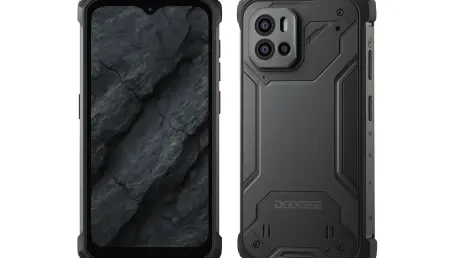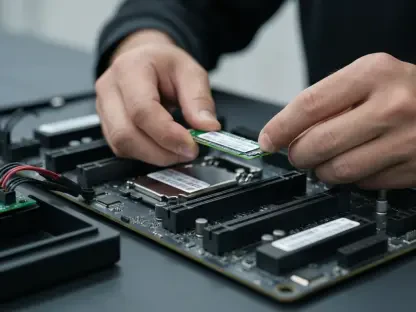Imagine dropping your smartphone during a grueling mountain hike or on a dusty construction site, only to pick it up unscathed and fully functional. This scenario drives the growing fascination with rugged smartphones, a niche where Doogee has carved out a notable presence. With the recent launch of the S200 Ultra and Fire 3, the tech community is abuzz with opinions on whether these devices deliver on their promise of durability paired with innovation. This roundup gathers insights from various industry voices, tech enthusiasts, and market analysts to dissect the hype surrounding Doogee’s latest offerings, aiming to provide a balanced perspective on their value and impact in the rugged smartphone arena.
Diving into Diverse Perspectives on Doogee’s Latest Releases
S200 UltrCutting-Edge Innovation or Overpriced Bulk?
The S200 Ultra has sparked significant discussion due to its dual-display design, featuring a 6.72-inch FullHD+ 120Hz LCD and a 1.32-inch circular AMOLED rear screen for quick notifications. Many tech reviewers highlight this as a bold move, noting that the Dynamic Breathing Light for alerts adds a unique flair to the rugged category. The specs, including the Dimensity 7400 SoC, 11,000 mAh battery, and 100MP camera system, have been praised by gadget blogs for rivaling premium non-rugged devices, positioning it as a serious contender for power users who need toughness.
However, not all feedback is glowing. Some industry watchers have pointed out the $569.99 price tag as a potential barrier, especially when paired with the device’s 19.1mm thickness. Comments from online forums suggest that while the durability certifications like IP68 and MIL-STD-810H are impressive, the bulkiness could deter users seeking a more portable option. This split in opinion raises questions about whether the S200 Ultra’s innovations justify its cost and design trade-offs.
A third angle comes from market analysts who see this device as a strategic push by Doogee into the premium rugged segment. They argue that features like reverse charging and a customizable key cater to niche demands among adventurers and professionals. Yet, there’s a lingering concern that the high price might limit its appeal to a broader audience, prompting debates on whether Doogee has overreached with this flagship model.
Fire 3: Budget-Friendly Toughness or Bare Minimum?
Shifting focus to the Fire 3, opinions vary on its role as an affordable rugged option at $209.99. Many budget-conscious reviewers appreciate the practical specs, such as the 8,350 mAh battery and expandable storage up to 2TB, seeing it as a solid choice for outdoor workers or casual users. Tech discussion groups often mention that the IP68 and IP69K ratings ensure reliability in harsh conditions, making it a standout in its price bracket.
On the flip side, some tech critics argue that the Unisoc SC9863A chip and 5.5-inch HD+ display fall short for users expecting more performance. Feedback from social media platforms indicates frustration over the modest 3GB RAM, with suggestions that it might struggle with multitasking even for basic needs. This perspective frames the Fire 3 as a device that sacrifices capability for affordability, leaving some to wonder if it’s too stripped down.
A balanced view emerges from industry observers who note that Doogee targets a specific demographic with this model—those prioritizing durability over speed. They commend the inclusion of features like NFC and a 3.5mm headphone jack, which add utility for the price. The consensus here seems to be that while the Fire 3 won’t wow tech enthusiasts, it fills a critical gap for cost-sensitive buyers needing a tough device.
Durability: Doogee’s Strength or Sole Selling Point?
Across both models, durability remains a central theme in discussions, with the shared IP68, IP69K, and MIL-STD-810H certifications earning consistent nods from reviewers. Industry blogs often emphasize how these standards make Doogee a go-to for sectors like construction and adventure tourism, where device resilience is non-negotiable. This focus is seen as a core strength, aligning with global trends toward rugged tech adoption in challenging environments.
Yet, some voices in tech podcasts caution against over-relying on ruggedness as the main draw. They argue that competitors in the niche are pairing durability with smarter software or sleeker designs, areas where Doogee might lag. The concern is that while the tough build is undeniable, the brand needs to match this with broader innovation to sustain long-term interest among discerning consumers.
Another perspective from market trend reports suggests that Doogee’s emphasis on durability reflects a deeper understanding of user needs in extreme conditions. Analysts point out that practical additions like customizable keys show an intent to go beyond mere toughness. The debate continues on whether this foundation alone can keep Doogee ahead in a market increasingly crowded with versatile rugged options.
Design Strategy: Broad Appeal or Confusing Direction?
Doogee’s dual approach—offering both a premium S200 Ultra and a budget Fire 3—has sparked varied reactions. Many tech commentators appreciate the strategy of catering to diverse price points, seeing it as a way to expand market reach. Features like reverse charging on both devices are often cited as thoughtful touches that enhance usability across user groups, reflecting a nuanced design philosophy.
Contrasting views emerge from online tech communities, where some users feel the stark contrast between the two models creates confusion about Doogee’s brand identity. They question if the high-end focus of the S200 Ultra clashes with the no-frills vibe of the Fire 3, potentially alienating fans expecting consistency. This critique suggests that straddling both ends of the spectrum might dilute the brand’s message.
Insights from industry analysis lean toward optimism, noting that this divergence could set a precedent for other rugged phone makers. Observers argue that targeting varied segments shows adaptability, especially as consumer demands evolve from 2025 onward. The discussion remains open on whether this bold split will solidify Doogee’s position or stretch its resources too thin in a competitive landscape.
Key Takeaways from the Rugged Smartphone Debate
Compiling these perspectives, it’s evident that the S200 Ultra stands out for its innovative dual-display and powerhouse specs, though its price and bulk draw criticism from some corners. The Fire 3, meanwhile, garners favor for affordability and durability but faces scrutiny over performance limitations. Opinions on Doogee’s durability focus are largely positive, yet there’s a call for more rounded advancements to match competitors.
Market voices also highlight the strategic intent behind Doogee’s varied design choices, with mixed feelings on whether this broad targeting will pay off. For potential buyers, the advice is clear: consider the S200 Ultra for cutting-edge needs in tough environments, and opt for the Fire 3 if budget and basic reliability are priorities. These insights offer a roadmap for navigating the hype around these devices.
Reflecting on Doogee’s Impact in the Rugged Arena
Looking back, the discourse around Doogee’s S200 Ultra and Fire 3 reveals a brand determined to balance durability with modern appeal, even as opinions differ on the execution. The roundup of views underscores both the potential and the pitfalls of these launches, painting a picture of a company at a pivotal moment. For those intrigued by rugged smartphones, the next step lies in testing these devices against personal or professional demands—perhaps by exploring user reviews or hands-on demos. Additionally, keeping an eye on how Doogee responds to feedback in upcoming models could provide clues about the evolving direction of this niche market.









